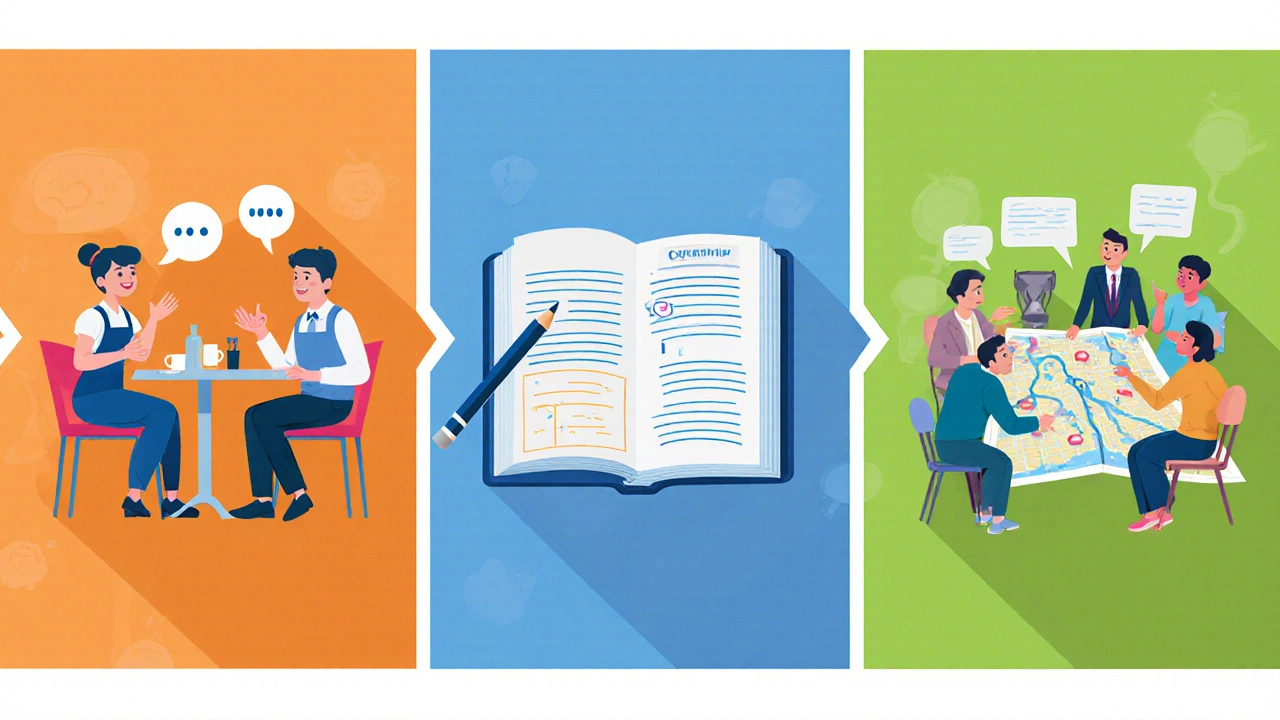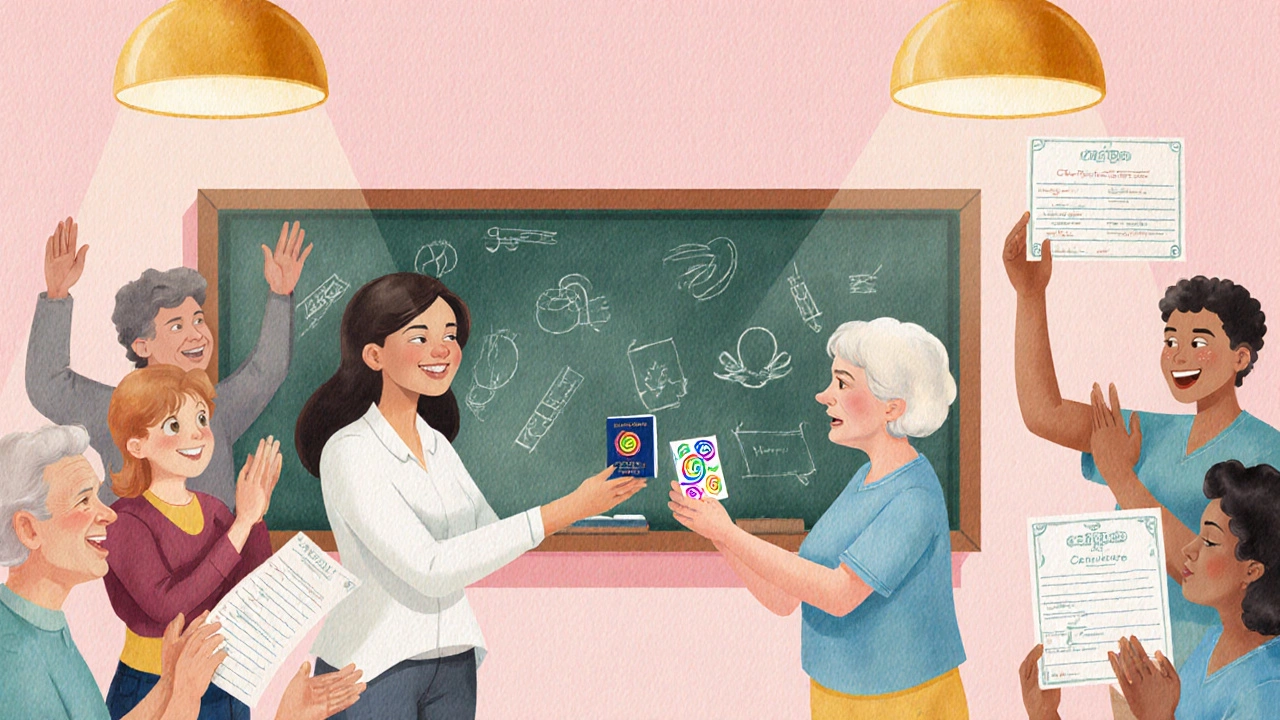Adult English Learning Planner
Greetings & Personal Info
Vocabulary: Hello, My name is..., pronouns
Grammar: Present simple 'to be'
Numbers & Time
Vocabulary: Counting 1-100, What time is it?
Grammar: Telling time, dates
Daily Routines
Vocabulary: Morning routine, frequency adverbs
Grammar: Present simple verbs
Food & Ordering
Vocabulary: Meals, polite requests
Grammar: 'Can I have...', 'I would like...'
Directions & Transport
Vocabulary: Prepositions, transport
Grammar: Modal 'can', asking for directions
Workplace Basics
Vocabulary: Job titles, emails
Grammar: 'I would like...'
Shopping & Money
Vocabulary: Currency terms, comparisons
Grammar: Comparative adjectives
Review & Project
Presentations on hobbies
Integrated language review
Your Weekly Progress Tracker
Current Week: Week 1
Progress: 12.5%
Lesson Structure Overview
- Warm-up 5 min
- Input 10 min
- Practice 20 min
- Wrap-up 5 min
Teaching Method Recommendations
Communicative Approach
Real-world interaction
Best for: Speaking confidence
Grammar-Translation
Explicit grammar rules
Best for: Structured learners
Task-Based Learning
Goal-oriented tasks
Best for: Workplace needs
Teaching English to adults who are just starting can feel like a tightrope walk - you need to balance clarity, relevance, and motivation without drowning anyone in jargon. The good news? With the right roadmap, you can build confidence, spark conversation, and see real progress week after week.
Quick Takeaways
- Apply adult learning principles (andragogy) to keep lessons relevant.
- Start with high‑frequency vocabulary and functional phrases.
- Mix communicative activities with short, focused grammar bursts.
- Use real‑life materials - news clips, menus, job ads - that matter to your learners.
- Check understanding often with quick, low‑stakes assessments.
Understanding the Learner: Adult‑Centric Foundations
Teaching English to adult beginners is the process of guiding learners who have little or no prior exposure to English, using methods that respect adult learners' life experience, goals, and self‑direction. Adults differ from younger students in three key ways:
- They bring a wealth of personal experience that can be leveraged as learning material.
- They are goal‑oriented - often learning for work, travel, or community integration.
- They prefer practical, immediately usable language over abstract drills.
Recognising these drivers helps you design lessons that feel purposeful rather than punitive.
Choosing Effective Teaching Methods
Not every method works for every group. Below is a quick snapshot of three popular approaches and when they shine.
| Method | Core Focus | Best For | Typical Activities |
|---|---|---|---|
| Communicative Approach | Real‑world interaction | Learners who need speaking confidence fast | Role‑plays, information gap tasks, interviews |
| Grammar‑Translation | Explicit grammar rules | Students who thrive on structure and analysis | Sentence parsing, translation exercises |
| Task‑Based Learning | Goal‑oriented tasks | Workplace learners needing functional language | Planning a trip, composing an email, solving a problem |
In practice, a blended mix works best. Start a lesson with a short communicative warm‑up, introduce a grammar point in context, then let learners complete a task that demands the new language.

Structuring Your First 8‑Week Curriculum
Below is a week‑by‑week blueprint that you can customise. Each week follows a four‑stage pattern:
- Warm‑up: 5‑minute real‑life prompt (e.g., “What did you have for breakfast?”).
- Input: Introduce 5-7 high‑frequency words and one grammatical structure.
- Practice: Pair or group task where learners use the language.
- Wrap‑up: Quick oral or written check‑in to gauge retention.
Here’s the outline:
- Week 1 - Greetings & Personal Info: “Hello”, “My name is…”, basic pronouns, present simple ‘to be’.
- Week 2 - Numbers & Time: Counting 1‑100, asking “What time is it?”, telling the date.
- Week 3 - Daily Routines: Frequency adverbs (always, usually), present simple verbs (work, eat).
- Week 4 - Food & Ordering: Vocabulary for meals, request phrases, polite forms.
- Week 5 - Directions & Transport: Prepositions of place, modal ‘can’ for ability, asking for directions.
- Week 6 - Workplace Basics: Job titles, simple email structure, “I would like…”.
- Week 7 - Shopping & Money: Currency terms, “How much…?”, comparative adjectives.
- Week 8 - Review & Mini‑Project: Learners plan a short presentation on a favorite hobby using all covered language.
Adjust pacing based on class size, attendance, and feedback.
Creating Engaging Materials
Adults learn best when the content mirrors their lives. Instead of textbook dialogues, pull in:
- Local news headlines (Authentic Articles) - discuss main ideas in simple sentences.
- Job advertisements - identify required skills, practice “I have experience in…”.
- Menu PDFs - role‑play ordering at a café.
- Short YouTube clips with subtitles - practise listening and summarising.
When you recycle real items, learners see the immediate payoff of their effort.
Managing Common Challenges
Even with a solid plan, you’ll hit snags. Here’s how to navigate them:
| Challenge | Root Cause | Practical Fix |
|---|---|---|
| Fear of speaking | Past negative experiences | Start with pair work that feels low‑stakes, use praise that focuses on effort. |
| Time constraints | Work/family commitments | Offer micro‑tasks (5‑minute listening drills) they can do at home. |
| Low motivation after a few weeks | Perceived lack of progress | Introduce visible milestones - e.g., a “conversation passport” with stamps for each successful dialogue. |
| Limited classroom interaction | Large class size | Use breakout groups, rotating roles (speaker, listener, note‑taker). |
Addressing the why behind each issue keeps the class moving forward.

Assessing Progress without Stress
Assessment for adults should be informal, frequent, and tied to real goals.
- Observation Checklists: Note who initiates conversation, who uses new vocab.
- Exit Tickets: One‑sentence summary of the day’s lesson.
- Mini‑Quizzes: 5‑question multiple choice focusing on core words.
- Goal Interviews: At the start and end of the course, discuss personal language targets.
These tools give you data while keeping the atmosphere supportive.
Putting It All Together: A Sample Lesson Blueprint
Below is a fully fleshed‑out 60‑minute lesson for Week 4 (Food & Ordering) that you can copy‑paste into your lesson planner.
- Warm‑up (5min): Show a picture of a bustling café. Ask, “What do you think people are ordering here?”
- Input (10min): Introduce vocabulary - coffee, tea, sandwich, bill, please, thank you. Write on board with pictures. Explain polite request forms: “Can I have…?” and “I would like…”.
- Pronunciation focus (5min): Highlight the /ʃ/ sound in “sandwich”. Use a Pronunciation Drill where learners repeat in chorus, then individually.
- Practice - Role‑Play (20min): Pair learners. One plays the customer, the other the barista. Provide a simple order sheet. Rotate roles after 10 minutes.
- Task - Menu Creation (10min): In small groups, design a three‑item menu using the new words. Each group presents their menu, and classmates place a mock order.
- Wrap‑up (5min): Quick exit ticket: “Write one sentence you would say to order food.” Collect and give immediate feedback.
- Homework: Record yourself ordering a meal in English and send the audio to the teacher.
This structure hits every learning objective - vocabulary, grammar, speaking, listening, and confidence.
Resources for Ongoing Development
Continue sharpening your toolkit with these free or low‑cost options:
- BBC Learning English - short news clips with transcripts.
- Duolingo Stories - interactive narratives for listening practice.
- TeachingEnglish (British Council) - lesson plans and worksheets.
- Local community centre bulletin boards - gather authentic flyers for class activities.
Mix digital tools with tangible printouts to keep lessons fresh.
Frequently Asked Questions
How many new words should I introduce per lesson?
For adult beginners, five to seven carefully chosen high‑frequency words work best. This amount lets learners practice each word in different contexts without feeling overloaded.
Do I need to teach English grammar in depth?
Focus on functional grammar - the forms learners will actually use. Introduce a rule, show it in a real dialogue, then let students practice it in a task. Deep theoretical explanations can wait until later stages.
What if my class has mixed skill levels?
Group the stronger learners with the weaker for pair work; the stronger can model language. Offer optional extension activities (e.g., extra reading) for those who finish early.
How can I keep adult learners motivated over months?
Set personal language goals early (e.g., “I want to ask for directions confidently”). Celebrate milestones with certificates or simple “language passports”. Relate each lesson to a real‑world need like a job interview or travel plan.
Is it okay to use my native language in class?
A few strategic translations can clarify tricky points, but aim for maximum exposure to English. Use the native language sparingly - just enough to prevent frustration.
With a clear plan, realistic expectations, and materials that matter, you’ll see adult beginners move from hesitant nods to confident chats. Remember: every sentence they speak is a step toward greater independence, and your role is to make that step as smooth as possible.
